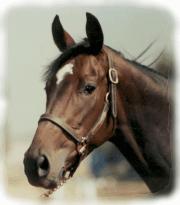A Horse, of Course with Don Blazer |
If you enjoy learning about horses, then you'll love our online courses. Each month you'll find a new column on our web site. We hope you'll enjoy it, and maybe e-mail us with questions or suggestions for other columns. A Horse, Of Course is a monthly column syndicated by Success Is Easy. If you like the column, call your local newspaper, or local horse publication and ask them to subscribe by contacting Success Is Easy. |
Is Your Horse "Busy as a Beaver"? Don Blazer copyright©2013 |

When you don’t keep horses as busy
as little beavers, that’s exactly what they become. And their “wood
sculpturing” isn’t highly appreciated. Besides being detrimental to the appearance of wood fences and stall doors, wood chewing is a costly vice that can be dangerous to the horse. Splinters in the horse’s stomach and intestines can cause colic, infection and internal bleeding. Deaths linked to wood chewing are not unusual. Wood chewing and cribbing are not the same. When a horse cribs, he places his teeth on a handy object—a fence or stall door, and then sucks in air, filling his stomach and ruining his appetite. Cribbers general show poor condition, have enlarged muscles in the throat just behind the jaw and severely wear away their teeth. Cribbing is such a bad vice that most sale companies make it mandatory the seller report the vice or the sale can be nullified. There are cribbing straps (a leather belt like strap which fits around the throat to keep the horse from expanding his throat) and other devices designed to stop the cribbing. Very few are effective. The only thing I’ve found to work is the practice of spreading the horse’s hay all around the stall or feeding area so that the horse has to look for it, and “pick” it out of the bedding or off the ground. The fact that the horse has to hunt for forage and use his nose to select it seems to be the key. The horse both works harder to find the forage (that keeps him busy) and he uses his lips as he would if he were eating grass in a natural setting. Wood chewing and cribbing are generally habits the horse develops out of nervousness or boredom. But they can be signs of other serious problems, such as a lack of nutrients in the diet, or his feed does not satisfy his natural desire for roughage. What contributes to making our lives easier is not always good for the horse, and we often fail to recognize the needs of a horse. Examples of human thoughtlessness that can lead to wood chewing include feeding pellets instead of roughage, using small box stalls and not giving the horse sufficient exercise. From an owner’s viewpoint, pellets are a convenient form of feed. But many studies indicate horses fed pellets develop a strong urge to chew after their appetites have been satisfied. The only experiment I conducted proved to me while the pellets may be nutritious, they simply don’t satisfy the horse as roughage does. Being confined in a small place can have negative psychological effects on a horse. When he cannot see all the activity around him---normally very interesting to the average horse—wood chewing becomes a way to express his displeasure, if not an attempt to chew his way to freedom. Nervousness caused by a lack of exercise often results in wood chewing. The horse simply has excess energy and finds that wood chewing relieves some of his tension, just as many humans get rid of nervous frustration by biting their fingernails. If wood chewing is a sign of a missing nutrient, it is probably salt. Every horse should have free access to a salt block or be fed a small handful of loose table salt each day. Reducing nervous tension, eliminating boredom and supplying the proper roughage and nutrients are the only satisfactory solutions to wood chewing. Solutions that are dangerous, costly or ineffective after a short period of time include the use of Tabasco sauce or other hot spices, covering stall doors or fence rails with woven wire, metal strips or electrified wire. Think “horse” before he morphs into a beaver. |